Soviets Admit 197 Injuries, Claim Crisis Is Controlled
- Share via
MOSCOW — The Soviet government, while reassuring its citizens Wednesday that the runaway nuclear facility near Kiev is under control, acknowledged that at least 197 people were injured in the accident in addition to the two already reported killed.
Reporting that the radiation level at the Chernobyl nuclear plant in the Ukraine was falling, the Soviet Council of Ministers said the damaged reactor “is shut down” and that “only 197 people were hospitalized (and) 49 of them were discharged from the hospital after a medical examination.”
“Enterprises, collective farms and state farms and institutions are functioning normally,” the council said.
Western diplomats, however, said they believe that a radioactive fire is still burning at the plant despite the statement from the Council of Ministers, which nominally functions as the Soviet Cabinet.
The U.S. Embassy warned Americans to stay away from Kiev, 60 miles south of the Chernobyl plant, while the British and French embassies asked their citizens to leave Kiev because of possible danger from high levels of radiation.
U.S. Ambassador Arthur A. Hartman issued a statement to Americans living in Moscow saying that the mission is trying to bring in radiation-monitoring equipment.
Science attaches from 12 Western embassies met at the U.S. Embassy on Wednesday morning to discuss the accident, but the Soviet government continued to reject the Western requests for additional information on the nuclear disaster.
“We are being stonewalled,” said one science attache after meeting with his colleagues. “There are many questions unanswered.”
A spokesman for the British Embassy said his country is trying to evacuate about 70 British students and tourists from Kiev and another 30 from Minsk, the capital of Soviet Byelorussia to the north.
Numbers Not Available
U.S. Embassy spokesman Jaroslav Verner said he does not know how many Americans were traveling in the Ukraine, but the State Department issued an advisory warning people to leave Kiev. The State Department said there was no indication of American casualties.
And unofficial sources continued to dispute the Soviet government’s reports that there were only two fatalities at Chernobyl. A Dutch amateur radio operator who monitored a radio conversation in the Soviet Union told the British Broadcasting Corp. in London that the exchange revealed that “many hundreds” of people have been killed and “maybe many, many more” were injured in the accident, the Associated Press reported.
The Dutchman, Annis Kofman, said he monitored a conversation between a Soviet radio operator near Kiev and a Japanese operator. The Ukrainian “said he thought many dead people could not be removed because of intense radiation,” Kofman said.
Kofman quoted the Soviet radioman as saying that “not one but two reactors were down, destroyed and burning.”
According to Kofman, the Ukrainian operator said that thousands of people are moving toward the south to escape the leaking radioactive material, the AP reported.
Ham operators across the United States said their Soviet counterparts ignored questions about the disaster.
“They’re avoiding it like the plague,” Joanie Branson, of Junction City, Ore., said. “They’re so closely monitored over there. If they say anything, they could be put off the air and lose their licenses.”
The Soviet announcement said the release of radioactive substances decreased during the 24 hours ending at 9 p.m. Wednesday Moscow time while radiation levels in the area around the power plant and its residential community were lowered.
“Measurements taken by specialists . . . show that the chain reaction of fission of nuclear fuel is not taking place,” the Council of Ministers statement said. “The reactor is shut down.”
But the government gave no specific figures to indicate how much radioactive substance had escaped or the peak level of radiation around the Chernobyl plant, a complex containing four nuclear reactors.
In a special report, the Soviet Union’s major evening television news program showed a photograph that a narrator said was taken of the damaged reactor a day after the accident.
Part Blown Away
While it presented only a side view, the photo appeared to indicate that at least the top of the reactor was blown away in the mishap.
But the TV narrator said the photo confirmed that there was no major catastrophe at the plant.
On the same TV program, preparations for the May Day parade in Kiev were shown to bolster the government’s assertion that life was proceeding normally there.
The Council of Ministers, quoting its counterpart body in the Ukraine, said air and water quality in Kiev were not a threat to public health.
One Western diplomat, however, said there was a “modest level of radioactivity” in the Kiev water reservoir and that there was apprehension about the nuclear accident among the 2.4 million residents of the city, the capital of the Ukraine, one of the Soviet republics.
‘Temporary Nature’
News correspondents based in Moscow were refused permission to travel to Kiev “for reasons of a temporary nature.”
Meanwhile, random interviews of Muscovites indicated that they accepted their government’s contention that there was no major danger from the Chernobyl accident.
Some people said they had not heard of the mishap, which has received only skimpy attention in the Soviet media. Others said they were confident that proper measures were being taken to eliminate any threat to health.
But one Soviet source said that people were aware of the possibility that radiation might spread to Moscow, and that they were expressing apprehension about health hazards.
The news about the nuclear accident was a blow to American travel agents and tour operators who were in Moscow in connection with the renewal of Pan American World Airways service to the Soviet Union.
“The incident near Kiev is killing our business,” said Alex Harris, a New York City tour operator who is deeply involved in U.S. travel to the Soviet Union. “We have been getting cancellations ever since the news came out.”
‘Silence Is Devastating’
Harris said he is trying to persuade Soviet officials to make a complete disclosure about the nuclear accident. “The silence is devastating,” he told a reporter.
The Soviet media Tuesday had reported that thousands were evacuated from the area of the accident, but there was no word Wednesday whether they had been allowed to return home.
Meanwhile, communications between the affected region in the Ukraine and the rest of the world were filtering out, presenting a contrast between surface normality and submerged calamity.
Roma Hadzewycz, editor of the Ukrainian Weekly, published in Jersey City, N.J., said three Ukrainians have told U.S. relatives by telephone that casualties from the disaster could be as high as 15,000.
Two Kiev residents, basing their report on the number of victims arriving at Kiev-area hospitals, estimated the number of casualties at 15,000, although it is unclear how many were fatalities, Hadzewycz said. “Hosptals are packed,” she said she was told. “People are being brought in bandaged and bloody.”
The third Ukrainian, a resident of Khmelnitski, reportedly was told by engineer friends that 15,000 had died and were buried in a nuclear waste disposal site identified as Pyrhove, about 150 miles southwest of the Chernobyl plant.
Meanwhile, at the University of Kiev, Dwayne Hnatiuk, a 20-year-old dance student from Edmonton, Canada, told his parents by phone that their telegram urging him to come home was his first notice that the situation was serious.
Hnatiuk called his mother, Marie Hnatiuk, on Wednesday. “They weren’t aware of the emergency,” she said. “They aren’t being told anything.”
Times staff writers George Stein and Mathis Chazanov, in Los Angeles, contributed to this story.
More to Read
Sign up for Essential California
The most important California stories and recommendations in your inbox every morning.
You may occasionally receive promotional content from the Los Angeles Times.










